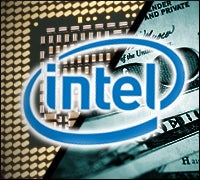 |
Surprises Good or Bad in Intel’s Earnings? |
Tuesday is the kick-off of second quarter earnings season, with Intel once again jumping out to take the lead and IBM coming on Thursday. What Wall Street analysts will want to hear from Intel and IBM’s CFOs this week will be their future projections.
In the case of Intel (NASDAQ: INTC), a more consumer-driven company than IBM (NYSE: IBM), seasonality plays a bigger role in earnings. The second calendar quarter is usually the slowest for the tech sector, and this quarter is largely viewed as a wash.
Or is it? Mercury Research President Dean McCarron thinks it might do well. “I think we’re going to see a little bit of an upside surprise in the market,” he told InternetNews.com. “We had this inventory problem that affected Q1. That’s a classic issue for a strong following quarter if the issue gets resolved, and it has been resolved. So I expect to see a little upside relative to Q1.”
McCarron said building mobile systems for the back to school period would have to start around June, and it ramps up aggressively through July and August. He has also noticed configurations seem to be bumping up in performance, which could be a hint of OEMs preparing for the October 22 launch of Windows 7.
FBR Capital Markets also noted a big jump in June orders. In a research note, it cited checks with the top five notebook original design manufacturers (ODMs) and top four desktop motherboard makers, and found Q2 notebook builds grew 14 percent from Q1, a big jump from the 10 percent quarter over quarter growth in May. Desktop motherboard builds tracked flat QOQ, which is a lot better than the 12 percent decline QOQ from May.
“Our contacts reported much stronger-than-expected June builds due to better demand pull out of Europe, continuing strength from China, new product momentum with CULV notebooks, and reduced component constraints,” the company wrote. For Q3, FBR is projecting 15 percent QOQ laptop growth and 11 percent desktop growth. (CULV stands for Consumer Ultra Low Voltage as in thin notebooks that require an extremely low power draw).
FBR projects Intel will report revenue growth in the range of four to 12 percent over Q1, a fairly wide range, for revenue between $7.6 billion to $8.2 billion, ahead of the Street estimate of $7.8 billion. It also projects earnings per share (EPS) of $0.10, while the Street is holding at $0.08.
There are two variables that can mess with Intel’s bottom line: how it accounts for the $1.4 billion fine levied by the European Commission earlier this year (which it’s appealing) and if it sees a charge for the acquisition of Wind River Systems this quarter.
Windows 7 can’t get here soon enough
McCarron thinks the dynamics this year will be lopsided due to Windows 7’s launch coming dead in the middle of Q4. “It looks like we will be rolling into a far stronger second half, especially in the fourth quarter. Compared to the first half of the year, it will be much better. Year over year, things probably won’t be all that pretty,” he adds.
Mike Feibus, president of TechKnowledge Strategies, also thinks the second half of the year is looking up. “You’re starting to hear about more capacity coming online, not just for CPUs but all parts. Everything’s coming together to suggest demand is solidifying. If there’s a fly in the ointment it’s just timing for all the releases,” he said.
Like McCarron, he thinks the late launch of Windows 7 will be a reason for delayed sales, as PC purchases that might happen in Q2 or Q3 are delayed until October, even with the free upgrades being offered to people who buy now. “Some of the second half mix might be more back-end loaded for a bang-up fourth quarter. That might steal a little from this quarter,” he told InternetNews.com
Another Windows 7 effect he’s noticed is that there haven’t been any revolutionary designs or major changes. OEMs have not embraced the new consumer ultra low voltage design that Intel and especially AMD are touting as competitors to netbooks, in offering a low-power draw laptop but without the constraints of a notebook.
“I think it’s a combination of risk aversion. They were making decisions at a time when we didn’t know if we were hitting bottom and then there was the Windows 7 phenomenon. I think they were thinking ‘Let’s not come with a new platform in the last few months of a consumer OS’s effective life,'” he said in reference to Windows Vista.


